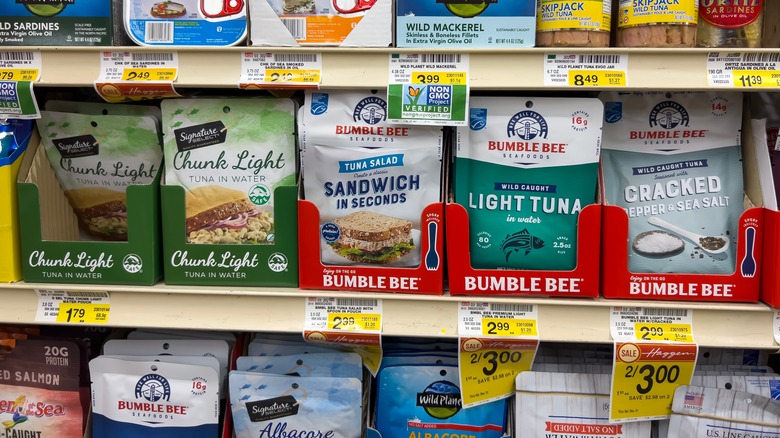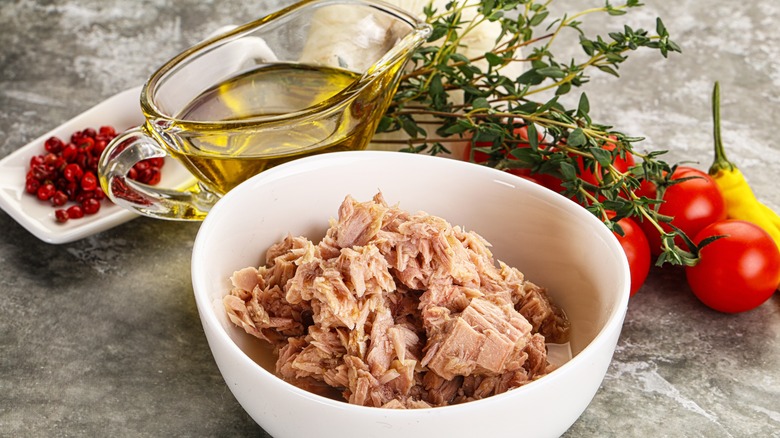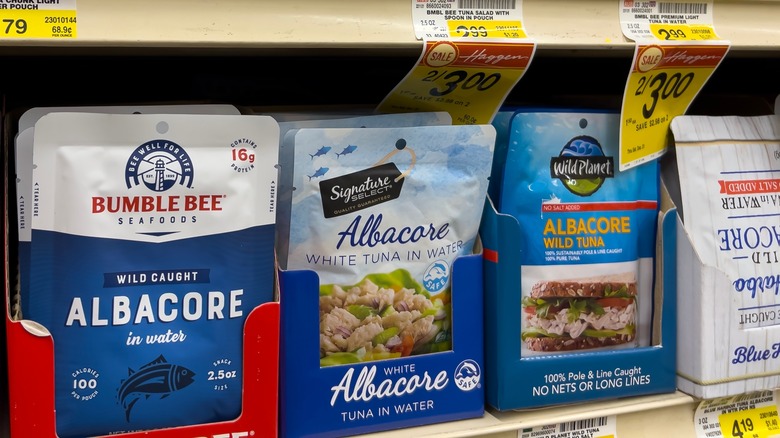Canned Vs Pouch Tuna: Is There A Difference Between The Two?
Tuna got a makeover in the year 2000 when StarKist put pretty pouches on shelves next to the standard old tin cans. The glow-up brought bright branding, single-serving packaging and a ton of pre-seasoned options with flavors like ranch, jalapeño and Thai chili. Instead of opening a can and mixing in spices, you could now just rip open a vacuum-sealed pouch and dig in. However, flavors aren't the only differences between pouch and canned tuna; the packaging impacts flavor and texture, and different tuna types work well for different dishes.
Tuna's reputation has transformed over the past century, rising from a throw-away fish to a household staple. It was first canned in 1903 and gained popularity thanks to two world wars that sent consumers searching for inexpensive protein and a shortage of sardines, which were the popular canned fish at the time. Marketing, like Van Camp Seafood's 1914 "Chicken of the Sea" campaign continued to turn public opinion toward tuna. Since that first can left the assembly line, the varieties of tuna brands, products, and packaging have only increased.
Product variety comes in handy, providing tuna fish options for all sorts of culinary adventures. High water content in canned tuna will help prevent a dry tuna casserole and canned tuna provides an unseasoned base for recipes, like tuna melts on English muffins. Pouch tuna doesn't have extra water because it's vacuum sealed. It works great as a topping for salads, on crackers as hors d'oeuvres and by itself as an easy snack.
Different tuna types for different tuna dishes
Water content, affordability, length of shelf life and convenience are all part of the differences between canned and pouch tuna. Both are marketed as low-cost, high-protein foods that work as a meal or a snack. However, pouch tuna costs about twice as much as canned tuna per ounce and although it's more convenient as a grab-and-go snack or light meal, you don't get as much meat per container. Canned tuna is more budget-friendly, but it requires a can opener and somewhat messy prep before eating.
Both canned and pouch tuna are pre-cooked and created to have a long shelf life. Pouch tuna isn't cooked for as long and doesn't last as long on the shelves. The shelf life of most pouch tuna varieties is three years, while canned tuna will keep for up to five years. Pouch tuna is also vacuum sealed, which eliminates the need for water preservation and makes for drier, flakier fish. It also comes pre-seasoned and canned version requires some extra ingredients to upgrade plain tuna to a delicious dish.
Speaking of added ingredients, those pre-seasoned pouch varieties of tuna can include things like added sugars or have a higher sodium content. Tuna canned in oil will have a higher fat content than its water-based counterpart. Thanks to the ever-expanding options, there's pretty much a tuna type for everybody and an option that will work perfectly for every dish.
Public opinion helped create the tuna pouch
Companies are always on the lookout for the next best thing, but it was public opinion on canned goods that, at least in part, prompted StarKist to release the pouch. The canning process dates back to 19th century France, so it has been a popular way to preserve and package food for a long time. But public concerns about canning started to grow in the 20th century with the news of botulism outbreaks related to canned goods. Anna Zeide details the canned food industry's bad PR in her 2018 book "Canned: The Rise and Fall of Consumer Confidence in the American Food Industry." One situation she writes about is the 1970 discovery of high mercury in canned tuna by Dr. Bruce McDuffie at the State University of New York in Binghamton. McDuffie's quickly publicized findings further tanked the reputation of canned goods.
News on the dangers of canned foods continued to circulate through the public in outlets like the Los Angeles Times and many others over the next few decades. By the year 2000, canned foods like tuna were generally accepted as emergency or inexpensive foods but were still considered less healthy and less desirable than fresher options. As consumers continued to be skeptical of canned goods, companies kept tuna in vogue by side-stepping the can and introducing the pouch with an ever-growing list of varieties and flavors.


